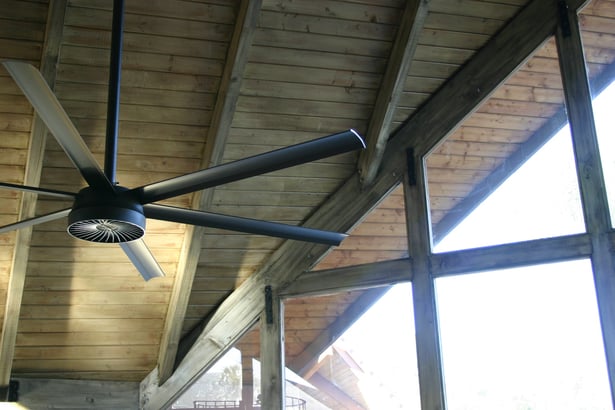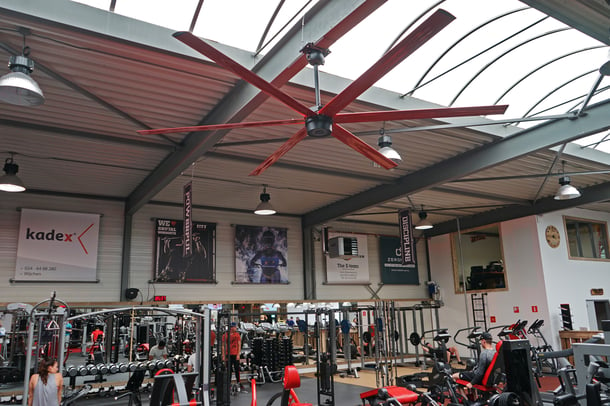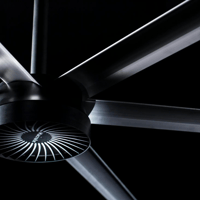Facility managers and engineers are always looking for the most efficient and cost-effective ways...
Ceiling Fans vs. Wall Fans: A Real World Comparison
Are you feeling the heat? Summer is here, and with it comes heat and humidity. As a business owner or manager, you know that providing the utmost comfort in your establishment is essential to get customers to keep coming back. Investing in fans for your restaurant, gym, or small business is an easy solution to keeping your customers (and employees) comfortable and content.
Now the big question is…ceiling fan vs. wall fan? Which one should you choose?
It may be difficult to decide which fan option is right for your business, as there are benefits to both. However, in this blog, we’ll explore what each fan has to offer and provide you with industry expertise from MacroAir's General Manager and fan expert, Geoff Herkner, so that you can make a well-informed decision for your business.
Ceiling Fan vs. Wall Fan: A Comparison
Wall Mount Fans

Wall-mount fans (or wall-mounted fans) differ from ceiling fans in that they’re mounted to the wall and are enclosed in a cage to prevent injury. They are designed to swivel back and forth at high speeds to pass air from one corner of the room to the other. With wall-mount fans, you would have to buy many fans to feel the breeze throughout the room.
Let's Hear from the Expert
According to Geoff Herkner, MacroAir's General Manager and fan expert, “the main point of differentiation [between ceiling fans and wall mount fans] is the difference in diameter. This also directly affects the max coverage area the fan can potentially affect.” Wall mount fans are much smaller than ceiling fans and they work great for directional airflow at a higher velocity. However, they are not ideal for moving air evenly throughout large spaces.
Wall fans are also not as efficient. Herkner explains that “since wall-mounted ceiling fans typically are smaller in diameter and produce air movement based on very high rotational speeds, they are very inefficient.” They often have less powerful motors, which creates heavy energy consumption. In fact, it takes multiple wall-mounted fans to displace as much air as one commercial ceiling fan.
However, although wall-mount fans may not be the most efficient option for large commercial spaces, they may be a perfect solution for smaller businesses that require more targeted airflow. They can be used in environments and spaces, such as:
- Smaller warehouses or stockrooms
- Loading docks
- Workshops or garages
- Fitness studios or smaller gyms
- Break rooms or smaller offices
- Agricultural areas lacking ceiling space (horse barns, kennels, etc.)
Check out these five great tips before purchasing wall-mount fans.
Ceiling Fans

The innovation of HVLS ceiling fans has changed the way fans move air around and provide comfort. They offer very efficient and balanced airflow for a variety of environments and spaces. One of the most common fans we see on a daily basis is ceiling fans.
Ceiling fans are fans that are mounted to the ceiling and move the air above you from the ceiling down. These fans come in various sizes, speeds, mount kits, and drop lengths to accommodate almost any environment and space you can imagine.
Here are several examples where ceiling fans can be used:
- Large warehouses
- Factories and manufacturing plants
- Gymnasiums and fitness centers
- Agricultural barns with larger ceiling spaces
- Event spaces (convention centers, exhibition halls, etc.)
- Retail spaces (restaurants, retail stores, shopping centers, etc.)
- Residential homes
Additionally, ceiling fans allow for evenly distributed air movement while using fewer fans due to having a wider range of motion. A major benefit of using fewer large industrial ceiling fans rather than many smaller, faster wall-mounted fans is energy consumption.
Because of a ceiling fan’s larger circumference and specially designed airfoils (a.k.a. blades), it only takes one large ceiling fan to do the job of up to 34 traditional small fan units. Ceiling fans are also capable of moving larger amounts of air than commercial wall-mounted fans or floor fans because they’re mounted from above. Therefore, commercial spaces can be cooled more evenly.
With ceiling fans, there are many different sizes to choose from. Smaller tabletop ceiling fans offer less air movement than their larger cousin, the industrial HVLS ceiling fan. Smaller ceiling fans range between 42-60 inches with diameters ranging from 6-24 feet. These huge fans move around 13 times more air than their smaller ceiling fan cousins. Additionally, an average small fan spins several times faster than the speed of a big industrial fan, making the fan noisier and consuming more power.
Let's Hear from the Expert
According to Herkner, who specializes in HVLS ceiling fans, “Big commercial ceiling fans will help reduce energy usage when placed properly. They will help cut down energy consumption in conjunction with HVAC units as well as individual heating units. This is due to the nature of the airflow of these large fans. They equalize air temperature from floor to ceiling within minutes, and therefore, have a strong effect on air turnover rates. This keeps customers' HVAC or heating systems run-time to a minimum while maintaining the desired temperature set-point.”
He went on to say, “Large diameter fans (HVLS fans) produce airflow generated with an airfoil that is engineered to provide the maximum amount of airflow at the lowest rotational speed. This provides greater efficiency than any small fan.”
Our Recommendation

Do what’s best for your space! Each space and environment offers unique needs and challenges. So, if you need directional, high-speed air movement, then wall-mount fans are a great option. If you need a quiet fan that provides a wide range of efficient air movement, then you’ll want to go with ceiling fans. If your business requires a combination of directional and wide-spread airflow, you can have the best of both worlds and get both!
MacroAir industrial fans offer the latest in innovative HVLS ceiling fan technology, providing efficient means for creating cooling comfort throughout your space. This is a surefire way to keep you, your customers, and your employees cool and comfortable year-round!
To learn more about our line of HVLS fans, visit the MacroAir website today! Even better, contact us for more information so we can help you find the perfect option for your commerical space! Our knowledgeable customer care representatives are available to answer any questions you may have.
Leave Your Thoughts
So, ceiling fans vs. wall mounted fans? What’s your conclusion? Can you feel the difference? Leave your comment below.
